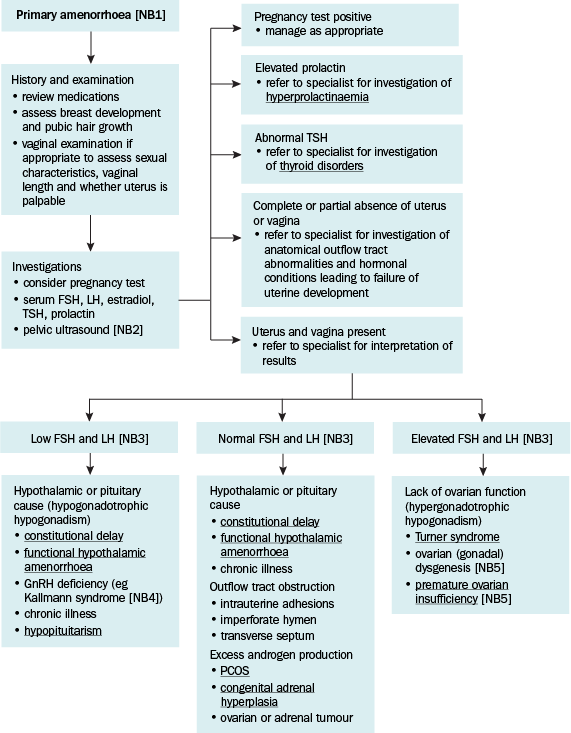Causes of and investigations for primary amenorrhoea
The most common causes of primary amenorrhoea include:
-
hypogonadotrophic causes such as
- constitutional delay (delay in completing spontaneous puberty)—a normal variant, often seen in females with a family history of delayed puberty), which occurs in approximately 30% of patients
- hypothalamic amenorrhoea (most commonly, functional hypothalamic amenorrhoea [due to conditions such as stress, excessive exercise, systemic illness, eating disorders and very low body weight], and isolated gonadotrophin-releasing hormone deficiency [eg Kallmann syndrome1])
- pituitary causes, such as hypopituitarism and prolactinoma
-
hypergonadotrophic (ovarian) causes (including Turner syndrome) leading to
- ovarian (gonadal) dysgenesis (streak gonads)
- premature ovarian insufficiency
- anatomical outflow tract abnormalities such as
- Mullerian agenesis (absence of the vagina or uterus)2
- imperforate hymen
- other hormonal conditions that affect production of or response to androgens, such as androgen insensitivity3 and 5-alpha-reductase deficiency4.
Less common causes of primary amenorrhoea include excess production of androgens resulting from polycystic ovary syndrome (PCOS) or nonclassical congenital adrenal hyperplasia.
For investigations for causes of primary amenorrhoea, see Investigations to determine the cause of primary amenorrhoea. Initial investigations can be performed in general practice, but specialist referral is usually required for interpretation of results and management.

FSH = follicle stimulating hormone; GnRH = gonadotrophin-releasing hormone; LH = luteinising hormone; PCOS = polycystic ovarian syndrome; TSH = thyroid stimulating hormone
NB1: Primary amenorrhoea is defined as absence of menarche: by age 13 years in a female without breast development; by age 15 years in a female with normal growth and breast development; by 5 years after breast development that occurred before age 10 years.
NB2: A transvaginal ultrasound gives best detail; a transabdominal ultrasound is an alternative if a transvaginal scan is not available or is declined.
NB3: Tests may need to be repeated after 4 to 6 weeks to clarify or confirm diagnosis.
NB4: For information on Kallmann syndrome, see the US National Library of Medicine Medline Plus website.
NB5: Ovarian dysgenesis and premature ovarian insufficiency each have a range of causes, including Turner syndrome.
